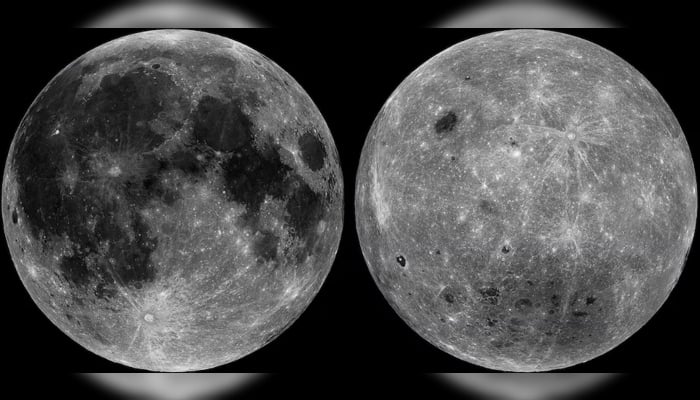An in-depth analysis of lunar gravity, utilizing data collected by the National Aeronautics and Space Administration’s (Nasa) twin robotic spacecraft, offers new insights into the distinct appearances of the moon’s nearside (the side perpetually facing Earth) and farside (the side always facing away).
The data from the US space agency’s Gravity Recovery and Interior Laboratory (Grail) mission indicates that the moon’s deep interior possesses an asymmetrical structure. This asymmetry was caused by intense volcanism on its Earth-facing side billions of years ago, which played a significant role in shaping its current surface features.
The researchers discovered that the lunar nearside experiences slightly more flexing than the farside during its elliptical orbit around Earth due to our planet’s gravitational pull – a phenomenon known as tidal deformation. This difference in flexing suggests variations in the two sides of the lunar interior, particularly within the geological layer called the mantle.
“Our study shows that the moon’s interior is not uniform: the side facing Earth — the nearside — is warmer and more geologically active deep down than the farside,” stated Ryan Park, supervisor of the Solar System Dynamics Group at Nasa’s Jet Propulsion Laboratory in California and the lead author of the study published on Wednesday in the journal Nature.
The moon’s nearside is characterized by vast, smooth plains called maria, formed from molten rock that cooled and solidified billions of years ago. In contrast, its farside exhibits a much more rugged terrain with fewer of these plains.
Some scientists have proposed that intense volcanism on the nearside, which caused radioactive, heat-generating elements to accumulate on that side of the mantle, drove the surface differences observed today. The new findings provide the strongest evidence to date supporting this hypothesis.
The researchers estimated that the nearside mantle is, on average, about 180-360 degrees Fahrenheit (100-200 degrees Celsius) hotter than the farside. This thermal difference is likely sustained by the radioactive decay of elements like thorium and titanium concentrated on the nearside.
“The moon’s nearside and farside look very different, as shown by differences in topography, crustal thickness and the amount of heat-producing elements inside,” Park explained.
The moon has a diameter of approximately 2,160 miles (3,475 kilometers), slightly more than a quarter of Earth’s diameter. The lunar mantle, the layer beneath the crust and above the core, extends to a depth of about 22-870 miles (35-1,400 km) below the surface. The mantle constitutes roughly 80% of the moon’s mass and volume and is primarily composed of the minerals olivine and pyroxene, similar to Earth’s mantle.
“The fact that the detected asymmetry in the mantle matches the pattern of the surface geology — for instance, differences in the abundance of the approximately three to four billion-year-old mare basalts (volcanic rock) between the nearside and the farside — suggests that processes which drove ancient lunar volcanism are active today,” said Caltech computational planetary scientist and study co-author Alex Berne, affiliated with the Jet Propulsion Laboratory where he works on the design of gravity sensors for missions to the outer solar system.
The researchers spent years analyzing data from Grail’s Ebb and Flow spacecraft, which orbited the moon from December 2011 to December 2012.
“Our study delivers the most detailed and accurate gravitational map of the moon to date,” Park stated.
“This enhanced gravity map is a critical foundation for developing lunar Positioning, Navigation and Timing (PNT) systems, which are essential for the success of future lunar exploration missions. By improving our understanding of the moon’s gravity field, it contributes to establishing a precise lunar reference frame and time system, enabling safer and more reliable navigation for spacecraft and surface operations,” Park added.
The researchers suggest that the same approach used in this study, employing gravity data to assess the lunar interior, could be applied to other bodies in the solar system, such as Saturn’s moon Enceladus and Jupiter’s moon Ganymede – two worlds of significant interest in the search for potential life beyond Earth.
In the meantime, these new findings enhance our understanding of Earth’s constant companion.
“The moon plays a vital role in stabilising Earth’s rotation and generating ocean tides, which influence natural systems and daily rhythms,” Park said. “Our knowledge of the moon has expanded through human and robotic missions that have revealed details about its surface and interior, yet many questions about its deep structure and history remain. As our closest neighbour, the moon continues to be an important focus of scientific discovery.”



